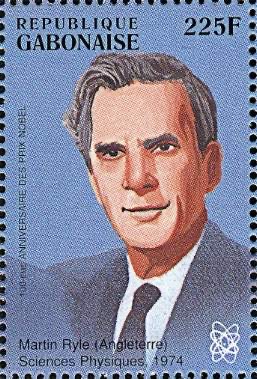Antony Hewish
Sir Martin Ryle

Nobel Prize for Physics (Sweden, 1987)
Antony Hewish (1924–2021) and Martin Ryle (1918–84) of the Mullard Radio Astronomy Observatory, Cambridge, were jointly awarded the 1974 Nobel Prize for Physics in recognition of their work in radio astronomy. Hewish was leader of the team which discovered pulsars, while Ryle developed the technique of aperture synthesis used for mapping radio sources in detail. They featured in a strip of five stamps commemorating Nobel-winning astrophysicists, issued in 1987 by Sweden, the country that bestows Nobel Prizes.
Hewish’s stamp (above left) shows the Crab Nebula, which contains a famous pulsar, overlain with the repeating trace of a radio pulse.
Ryle’s stamp (above right) shows the radio galaxy Centaurus A with a stylized representation of radio telescopes receiving radio waves from it.
The other scientists and their achievements honoured in the same set were:
• Arno Penzias and Robert Wilson (both on the same stamp), joint winners in 1978 for their discovery of the cosmic microwave background radiation;
• Subrahmanyan Chandrasekhar, joint winner in 1983 for his formulation of the Chandrasekhar Limit, the maximum possible mass for a white dwarf star;
• William Fowler, joint winner in 1983 for his work on nucleosynthesis (the origin of the heavy elements) in the Universe.
All five stamps had the same face value, 2.90 k, and the colours were either dark blue or black. They were engraved by Martin Mörck from original designs by Gábor Palotai.
Stanley Gibbons nos. 1369 and 1373
Martin Ryle (Gabon, 1995)

In 1995 the west African nation of Gabon issued stamps depicting various Nobel prize winners, among them Martin Ryle. The portrait was drawn from a photograph of him released at the time of the Nobel award in 1974. This scan comes from Joachim Reinhardt’s website of physics-related stamps.
Stanley Gibbons no. ??